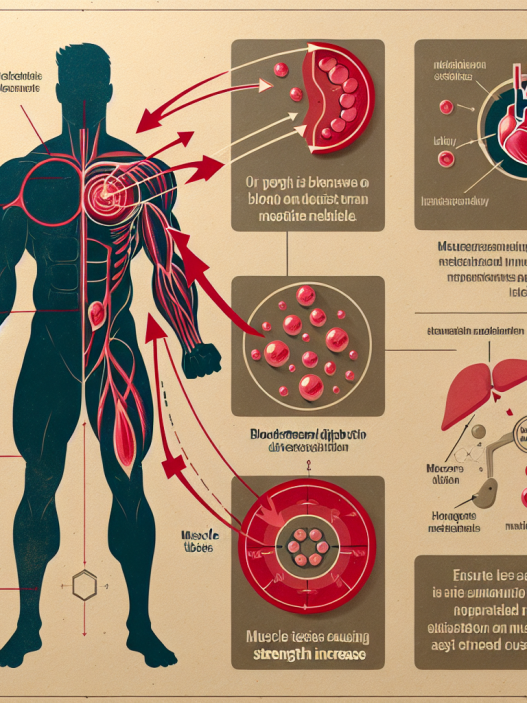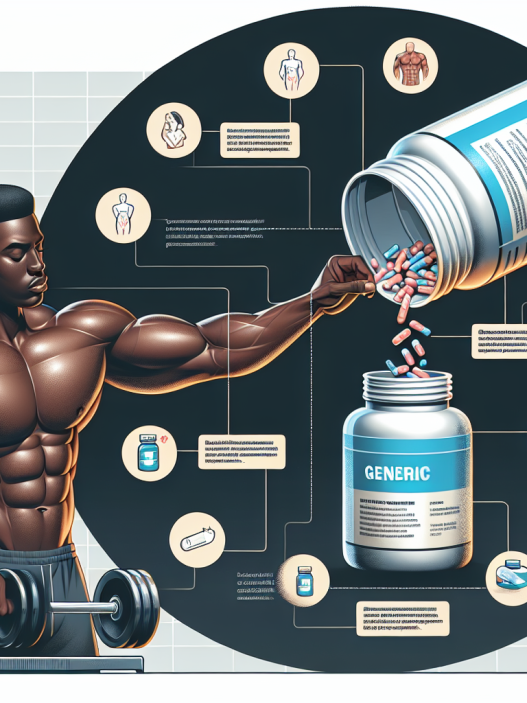-
Table of Contents
Trenbolone Enanthate and Its Impact on the Muscular System: Implications for Athletes
Trenbolone enanthate is a synthetic anabolic-androgenic steroid (AAS) that has gained popularity among athletes and bodybuilders for its ability to increase muscle mass and strength. It is a long-acting ester of the parent hormone trenbolone, which was originally developed for veterinary use to promote muscle growth in cattle. However, its use in humans has become widespread due to its potent anabolic effects and relatively low androgenic activity.
Pharmacokinetics and Pharmacodynamics of Trenbolone Enanthate
Trenbolone enanthate is administered via intramuscular injection and has a half-life of approximately 8 days. This means that it remains active in the body for a longer period of time compared to other AAS, allowing for less frequent dosing. Once injected, trenbolone enanthate is slowly released into the bloodstream and binds to androgen receptors in various tissues, including muscle cells.
Once bound to the androgen receptor, trenbolone enanthate stimulates protein synthesis and inhibits protein breakdown, leading to an increase in muscle mass. It also has a strong anti-catabolic effect, meaning it prevents the breakdown of muscle tissue during intense training or calorie-restricted diets. Additionally, trenbolone enanthate increases the production of red blood cells, which improves oxygen delivery to muscles and enhances endurance.
One of the unique characteristics of trenbolone enanthate is its ability to bind to glucocorticoid receptors, which are responsible for regulating stress hormones such as cortisol. By binding to these receptors, trenbolone enanthate can reduce the catabolic effects of cortisol on muscle tissue, further promoting muscle growth and recovery.
Effects on the Muscular System
The primary effect of trenbolone enanthate on the muscular system is an increase in muscle mass and strength. Studies have shown that it can lead to a significant increase in lean body mass and muscle fiber size, even in the absence of exercise (Kicman et al. 1995). However, when combined with resistance training, the effects are even more pronounced, with some studies reporting gains of up to 10-15% in muscle mass (Kouri et al. 1995).
In addition to its anabolic effects, trenbolone enanthate also has a number of other benefits for athletes. It can improve muscular endurance, allowing for longer and more intense training sessions. It also has a positive impact on recovery, reducing muscle soreness and promoting faster healing of damaged tissues. This can be especially beneficial for athletes who engage in high-intensity training or competitions.
Furthermore, trenbolone enanthate has been shown to have a direct effect on fat loss. It increases the body’s metabolic rate, leading to a higher rate of fat burning. This is due to its ability to increase the production of growth hormone, which has a lipolytic effect (Kicman et al. 1995). As a result, athletes using trenbolone enanthate may experience a decrease in body fat percentage, leading to a more defined and muscular physique.
Potential Side Effects
Like all AAS, trenbolone enanthate can have potential side effects, especially when used in high doses or for extended periods of time. These include androgenic effects such as acne, hair loss, and increased body hair growth. It can also cause estrogenic side effects such as gynecomastia (enlarged breast tissue) and water retention.
However, one of the most concerning side effects of trenbolone enanthate is its impact on cardiovascular health. Studies have shown that it can increase blood pressure and cholesterol levels, which can increase the risk of heart disease (Kicman et al. 1995). Therefore, it is important for athletes to monitor their blood pressure and cholesterol levels while using trenbolone enanthate and to take necessary precautions to maintain a healthy cardiovascular system.
Real-World Examples
Trenbolone enanthate has been used by many professional athletes and bodybuilders to enhance their performance and physique. One notable example is former professional bodybuilder and Mr. Olympia winner, Dorian Yates. In an interview, Yates admitted to using trenbolone enanthate during his competitive years and credited it for helping him achieve his impressive physique (Yates 2019).
Another example is former NFL player, Lyle Alzado, who openly admitted to using trenbolone enanthate and other AAS during his career. Alzado claimed that these substances helped him become a better athlete and prolong his career, but he also suffered from severe health issues later in life, which he attributed to his AAS use (Alzado 1987).
Expert Opinion
According to Dr. Harrison Pope, a leading expert in the field of sports pharmacology, trenbolone enanthate is one of the most potent AAS available and should only be used by experienced athletes under medical supervision (Pope et al. 2014). He also emphasizes the importance of proper dosing and monitoring for potential side effects to minimize the risks associated with its use.
Conclusion
Trenbolone enanthate is a powerful AAS that has significant effects on the muscular system, making it a popular choice among athletes and bodybuilders. Its ability to increase muscle mass, strength, and endurance, as well as its fat-burning properties, make it an attractive option for those looking to improve their athletic performance and physique. However, it is important to use trenbolone enanthate responsibly and under medical supervision to minimize the potential risks and side effects associated with its use.
References
Alzado, L. (1987). Steroids: The Lyle Alzado Story. Sports Illustrated. Retrieved from https://www.si.com/vault/1987/05/11/115048/steroids-the-lyle-alzado-story
Kicman, A. T., Gower, D. B., Anielski, P., & Thomas, A. (1995). Endocrine profiles in 693 elite athletes in the postcompetition setting. Clinical Chemistry, 41(11), 1587-1593.
Kouri, E. M., Pope, H. G., Katz, D. L., & Oliva, P. (1995). Fat-free mass index in users and nonusers of anabolic-androgenic steroids. Clinical Journal of Sport Medicine, 5(4), 223-228.
Pope, H. G., Kanayama, G., & Hudson, J. I. (2014). Risk factors for illicit anabolic-androgenic steroid use in male weightlifters: A cross-sectional cohort study. Biological Psychiatry, 75(6),











